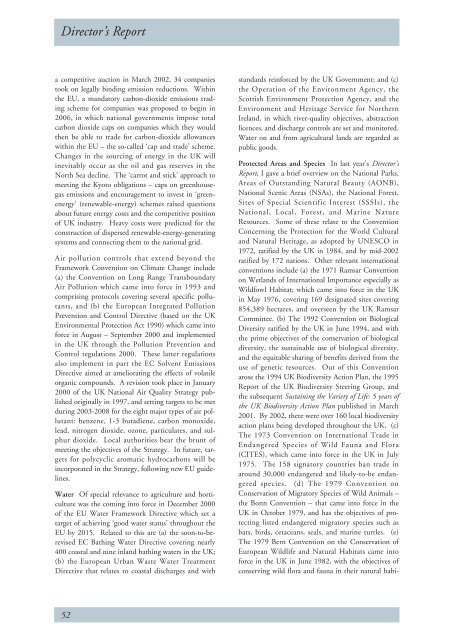PDF file: Annual Report 2002/2003 - Scottish Crop Research Institute
PDF file: Annual Report 2002/2003 - Scottish Crop Research Institute
PDF file: Annual Report 2002/2003 - Scottish Crop Research Institute
You also want an ePaper? Increase the reach of your titles
YUMPU automatically turns print PDFs into web optimized ePapers that Google loves.
Director’s <strong>Report</strong><br />
a competitive auction in March <strong>2002</strong>, 34 companies<br />
took on legally binding emission reductions. Within<br />
the EU, a mandatory carbon-dioxide emissions trading<br />
scheme for companies was proposed to begin in<br />
2006, in which national governments impose total<br />
carbon dioxide caps on companies which they would<br />
then be able to trade for carbon-dioxide allowances<br />
within the EU – the so-called ‘cap and trade’ scheme.<br />
Changes in the sourcing of energy in the UK will<br />
inevitably occur as the oil and gas reserves in the<br />
North Sea decline. The ‘carrot and stick’ approach to<br />
meeting the Kyoto obligations – caps on greenhousegas<br />
emissions and encouragement to invest in ‘greenenergy’<br />
(renewable-energy) schemes raised questions<br />
about future energy costs and the competitive position<br />
of UK industry. Heavy costs were predicted for the<br />
construction of dispersed renewable-energy-generating<br />
systems and connecting them to the national grid.<br />
Air pollution controls that extend beyond the<br />
Framework Convention on Climate Change include<br />
(a) the Convention on Long Range Transboundary<br />
Air Pollution which came into force in 1993 and<br />
comprising protocols covering several specific pollutants,<br />
and (b) the European Integrated Pollution<br />
Prevention and Control Directive (based on the UK<br />
Environmental Protection Act 1990) which came into<br />
force in August – September 2000 and implemented<br />
in the UK through the Pollution Prevention and<br />
Control regulations 2000. These latter regulations<br />
also implement in part the EC Solvent Emissions<br />
Directive aimed at ameliorating the effects of volatile<br />
organic compounds. A revision took place in January<br />
2000 of the UK National Air Quality Strategy published<br />
originally in 1997, and setting targets to be met<br />
during <strong>2003</strong>-2008 for the eight major types of air pollutant:<br />
benzene, 1-3 butadiene, carbon monoxide,<br />
lead, nitrogen dioxide, ozone, particulates, and sulphur<br />
dioxide. Local authorities bear the brunt of<br />
meeting the objectives of the Strategy. In future, targets<br />
for polycyclic aromatic hydrocarbons will be<br />
incorporated in the Strategy, following new EU guidelines.<br />
Water Of special relevance to agriculture and horticulture<br />
was the coming into force in December 2000<br />
of the EU Water Framework Directive which set a<br />
target of achieving ‘good water status’ throughout the<br />
EU by 2015. Related to this are (a) the soon-to-berevised<br />
EC Bathing Water Directive covering nearly<br />
400 coastal and nine inland bathing waters in the UK;<br />
(b) the European Urban Waste Water Treatment<br />
Directive that relates to coastal discharges and with<br />
standards reinforced by the UK Government; and (c)<br />
the Operation of the Environment Agency, the<br />
<strong>Scottish</strong> Environment Protection Agency, and the<br />
Environment and Heritage Service for Northern<br />
Ireland, in which river-quality objectives, abstraction<br />
licences, and discharge controls are set and monitored.<br />
Water on and from agricultural lands are regarded as<br />
public goods.<br />
Protected Areas and Species In last year’s Director’s<br />
<strong>Report</strong>, I gave a brief overview on the National Parks,<br />
Areas of Outstanding Natural Beauty (AONB),<br />
National Scenic Areas (NSAs), the National Forest,<br />
Sites of Special Scientific Interest (SSSIs), the<br />
National, Local, Forest, and Marine Nature<br />
Resources. Some of these relate to the Convention<br />
Concerning the Protection for the World Cultural<br />
and Natural Heritage, as adopted by UNESCO in<br />
1972, ratified by the UK in 1984, and by mid-<strong>2002</strong><br />
ratified by 172 nations. Other relevant international<br />
conventions include (a) the 1971 Ramsar Convention<br />
on Wetlands of International Importance especially as<br />
Wildfowl Habitat; which came into force in the UK<br />
in May 1976, covering 169 designated sites covering<br />
854,389 hectares, and overseen by the UK Ramsar<br />
Committee. (b) The 1992 Convention on Biological<br />
Diversity ratified by the UK in June 1994, and with<br />
the prime objectives of the conservation of biological<br />
diversity, the sustainable use of biological diversity,<br />
and the equitable sharing of benefits derived from the<br />
use of genetic resources. Out of this Convention<br />
arose the 1994 UK Biodiversity Action Plan, the 1995<br />
<strong>Report</strong> of the UK Biodiversity Steering Group, and<br />
the subsequent Sustaining the Variety of Life: 5 years of<br />
the UK Biodiversity Action Plan published in March<br />
2001. By <strong>2002</strong>, there were over 160 local biodiversity<br />
action plans being developed throughout the UK. (c)<br />
The 1973 Convention on International Trade in<br />
Endangered Species of Wild Fauna and Flora<br />
(CITES), which came into force in the UK in July<br />
1975. The 158 signatory countries ban trade in<br />
around 30,000 endangered and likely-to-be endangered<br />
species. (d) The 1979 Convention on<br />
Conservation of Migratory Species of Wild Animals –<br />
the Bonn Convention – that came into force in the<br />
UK in October 1979, and has the objectives of protecting<br />
listed endangered migratory species such as<br />
bats, birds, cetaceans, seals, and marine turtles. (e)<br />
The 1979 Bern Convention on the Conservation of<br />
European Wildlife and Natural Habitats came into<br />
force in the UK in June 1982, with the objectives of<br />
conserving wild flora and fauna in their natural habi-<br />
52
















